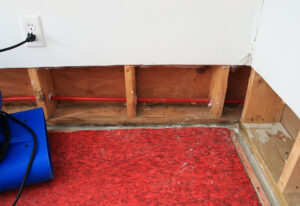
With the winter snows melting and the spring rains not far behind, now is a good time to address water damage around the home. Water damage is one of the most common homeowners insurance claims nationwide, costing billions of dollars annually. Water damage can happen at anytime of the year and oftentimes is inescapable, but there are several proactive, preventative steps you can take to safeguard against some of the most common and avoidable problems.
5 Inexpensive Jobs to Avoid Water Damage
There are a number of relatively easy and inexpensive jobs that any homeowner can do to lessen the likelihood of snow melt and spring rains seeping into the home:
- Caulk and seal windows to guard against water seepage.
- Inspect your roof for missing, damaged, and aging shingles or dislodged flashing. If you notice something that doesn’t look right, contact a roofing contractor to assess the damage and make repairs.
- Check your downspouts. Remove leaves and debris that may have accumulated in downspouts and gutters. Position and extend downspouts so that they direct water away from the house. If you have standing water after a rain, contact a landscaper to grade the area and channel water away from the foundation.
- Install gutter guards to prevent clogs and keep water flowing away from the house instead of accumulating on the roof. Gutter guards are inexpensive and available at most DIY and hardware stores, but if you are uncertain about heights, contact a roofing/gutter professional.
- Check sprinklers and irrigation systems to be sure they are not creating water damage to the walls and foundations of the house. Turn off and drain outside faucets in winter to protect against frozen pipes.
Different Types of Water Damage Are Insured Differently
 Like most everything in homeownership, steps taken to prevent common problems help avoid surprises and headaches and saves money in the long run. It is also important, however, for you to understand what is covered and not covered before your house suffers water damage. As a rule of thumb, water that comes from the top down such as rainfall, ice dams on the roof, or burst sprinklers is covered by a standard homeowners policy. Water that comes from the bottom up, from an overflowing creek or river, for example, is not, but is covered by purchasing a separate flood insurance policy. If you are not sure what type of policy you have and what it covers, call your agent for an explanation
Like most everything in homeownership, steps taken to prevent common problems help avoid surprises and headaches and saves money in the long run. It is also important, however, for you to understand what is covered and not covered before your house suffers water damage. As a rule of thumb, water that comes from the top down such as rainfall, ice dams on the roof, or burst sprinklers is covered by a standard homeowners policy. Water that comes from the bottom up, from an overflowing creek or river, for example, is not, but is covered by purchasing a separate flood insurance policy. If you are not sure what type of policy you have and what it covers, call your agent for an explanation
If you do need to file a claim, please give us a call at 877-355-3473 – we promise a timely response, courteous service, and guarantee you will have a higher settlement payment with our services than with working with insurance alone.
Free Damage Inspection Review





